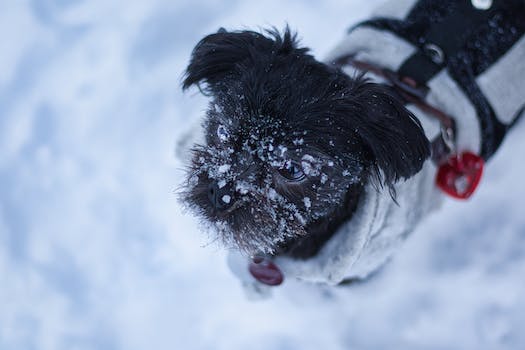Unraveling the roots of Affenpinschers: A journey into their fascinating origins.
The Affenpinscher is a small breed of dog that originated in Germany. It is known for its distinctive monkey-like appearance and lively personality. Understanding the origin of Affenpinschers can provide valuable insights into their characteristics and traits.
The History and Origins of Affenpinschers
The Affenpinscher is a small breed of dog that is known for its distinctive appearance and lively personality. But where did this unique breed come from? To understand the origin of Affenpinschers, we need to delve into their history and explore their origins.
The history of Affenpinschers can be traced back to Germany, where they were originally bred as rat catchers. Their name, which means “monkey-like terrier” in German, perfectly describes their appearance. With their shaggy coat, expressive eyes, and mischievous expression, Affenpinschers truly resemble little monkeys.
Although the exact origins of the Affenpinscher are unclear, it is believed that they are descendants of various small terrier breeds. These terriers were bred to be fearless and tenacious, making them excellent hunters of vermin. Over time, breeders selectively bred these terriers to create a distinct breed that we now know as the Affenpinscher.
During the 17th century, Affenpinschers gained popularity among the nobility in Germany. They were often kept as companion dogs and were even depicted in paintings alongside their aristocratic owners. Affenpinschers were cherished for their loyalty, intelligence, and playful nature, which made them excellent family pets.
In the late 19th century, Affenpinschers made their way to France, where they quickly gained popularity. French breeders further refined the breed, focusing on enhancing their unique physical characteristics. The French influence is evident in the modern Affenpinscher’s elegant appearance and refined demeanor.
Despite their rise in popularity, Affenpinschers faced a decline in numbers during World War I and World War II. The devastation caused by the wars led to a scarcity of resources, making it difficult for breeders to maintain and preserve the breed. However, dedicated enthusiasts worked tirelessly to revive the Affenpinscher population, ensuring its survival.
Today, Affenpinschers are cherished around the world for their distinctive looks and lively personalities. They are often described as “big dogs in small bodies” due to their confident and fearless nature. Affenpinschers are known for their intelligence and can be quite stubborn at times, making training a challenge. However, with patience and consistency, they can be taught to be well-behaved and obedient companions.
One of the most endearing qualities of Affenpinschers is their ability to form strong bonds with their owners. They thrive on human companionship and love being the center of attention. Affenpinschers are known to be protective of their families and will not hesitate to alert their owners to any potential danger.
In conclusion, the Affenpinscher is a unique breed with a fascinating history. Originating in Germany, these small terriers were bred for their hunting skills and eventually became beloved companions of the nobility. Despite facing challenges during times of war, Affenpinschers have managed to survive and thrive, capturing the hearts of dog lovers worldwide. With their distinctive appearance and lively personalities, Affenpinschers continue to bring joy and laughter to their owners, making them a truly special breed.
Tracing the Ancestry of Affenpinschers
Understanding the origin of Affenpinschers can be a fascinating journey into the past. These small, wiry-haired dogs have a distinct appearance and a lively personality that sets them apart from other breeds. To truly appreciate these delightful creatures, it is important to trace their ancestry and understand how they came to be.
The Affenpinscher, also known as the “Monkey Dog,” has a long history that can be traced back to Germany. It is believed that their ancestors were small terrier-like dogs that were bred to catch rats and other vermin in homes and stables. These dogs were highly valued for their ability to keep these pests at bay, and their small size made them perfect for navigating tight spaces.
As time went on, these terrier-like dogs were crossed with other breeds, such as the Pug and the Miniature Pinscher, to refine their appearance and temperament. This crossbreeding resulted in the Affenpinscher we know today, with its distinctive monkey-like face and mischievous personality.
One of the key characteristics of Affenpinschers is their wiry coat, which requires regular grooming to keep it looking its best. This coat is believed to have been developed to protect the dogs from the harsh weather conditions they would encounter while hunting vermin. The wiry hair acts as a barrier against the elements, keeping the dog warm and dry.
In addition to their unique appearance, Affenpinschers are known for their lively and spirited personalities. They are intelligent and curious dogs, always ready for an adventure. This playful nature is believed to have been bred into them to make them more effective at catching rats and other small prey. Their agility and quick reflexes make them excellent hunters, and their small size allows them to navigate tight spaces with ease.
Despite their small stature, Affenpinschers are known for their fearless nature. They are not afraid to stand up to larger animals or defend their territory. This bravery is believed to have been bred into them to make them effective at their original job of hunting vermin. Their tenacity and determination make them excellent watchdogs, always on the alert for any potential threats.
Today, Affenpinschers are beloved pets and companions. Their unique appearance and lively personalities make them a popular choice for dog lovers around the world. While they may no longer be used for hunting vermin, their instincts and traits are still very much a part of who they are.
Understanding the origin of Affenpinschers allows us to appreciate the rich history behind these delightful dogs. From their humble beginnings as rat catchers in Germany to their current status as beloved pets, Affenpinschers have come a long way. Their distinctive appearance, lively personality, and fearless nature make them a breed like no other. Whether you are a fan of their mischievous antics or simply admire their unique looks, Affenpinschers are sure to capture your heart.
Exploring the Evolution of Affenpinscher Breeds
Understanding the origin of Affenpinschers
When it comes to dog breeds, the Affenpinscher is a unique and fascinating one. With its distinctive appearance and lively personality, it’s no wonder that many people are curious about the origin of this breed. In this article, we will explore the evolution of Affenpinschers and shed light on their fascinating history.
The Affenpinscher is believed to have originated in Germany, where it was initially bred as a ratter. These small dogs were highly valued for their ability to hunt and catch rats, which were a common problem in households and farms during that time. Their name, Affenpinscher, translates to “monkey-like terrier” in German, which perfectly describes their mischievous and playful nature.
As time went on, the Affenpinscher’s role shifted from being a ratter to becoming a companion dog. Their charming looks and lively personality made them popular among the upper class, who enjoyed their company and entertaining antics. Affenpinschers were often seen accompanying their owners to social events and were even known to perform tricks to entertain guests.
During the late 19th century, the Affenpinscher breed faced a decline in popularity due to the rise of larger dog breeds. However, dedicated breed enthusiasts worked tirelessly to preserve and revive the breed. They focused on breeding Affenpinschers with desirable traits, such as a dense and wiry coat, a distinctive monkey-like face, and a lively and confident temperament.
In the early 20th century, the Affenpinscher gained recognition as a distinct breed and was officially recognized by kennel clubs. This recognition helped to increase their popularity and led to the establishment of breed standards, which outlined the ideal characteristics of the Affenpinscher.
Today, Affenpinschers are cherished as family pets and are known for their loyalty and affection towards their owners. They are also highly intelligent and trainable, making them suitable for various dog sports and activities. Despite their small size, Affenpinschers have a big personality and are often described as fearless and confident.
One of the most distinctive features of the Affenpinscher is its coat. Their dense and wiry fur requires regular grooming to maintain its appearance and prevent matting. Many owners choose to have their Affenpinschers professionally groomed to ensure their coat stays in top condition.
In terms of health, Affenpinschers are generally a robust breed. However, like all dogs, they are prone to certain health issues, including hip dysplasia, patellar luxation, and eye problems. Regular veterinary check-ups and a balanced diet are essential to keep them healthy and happy.
In conclusion, the Affenpinscher is a unique and fascinating breed with a rich history. From its origins as a ratter in Germany to its current role as a beloved companion dog, the Affenpinscher has come a long way. Their distinctive appearance, lively personality, and loyal nature make them a popular choice among dog lovers. Whether you’re considering adding an Affenpinscher to your family or simply curious about their origins, understanding their history can deepen your appreciation for this delightful breed.
Unraveling the Origins of the Affenpinscher’s Distinctive Appearance

The Affenpinscher is a small breed of dog that is known for its distinctive appearance. With its wiry coat, bushy eyebrows, and monkey-like face, the Affenpinscher stands out in a crowd. But have you ever wondered where this unique breed came from? In this article, we will delve into the origins of the Affenpinscher’s distinctive appearance and uncover the fascinating history behind this lovable little dog.
To understand the origin of the Affenpinscher, we must first look back in time to the 17th century in Germany. It is believed that the Affenpinscher was developed as a ratter, a dog bred specifically to catch and kill rats. The name “Affenpinscher” actually translates to “monkey-like terrier” in German, which perfectly describes the breed’s appearance.
The Affenpinscher’s distinctive facial features, such as its bushy eyebrows and beard, were likely developed to protect the dog’s face from the bites and scratches of the rats it was hunting. These features acted as a natural shield, preventing any harm from coming to the dog’s sensitive areas.
As the years went by, the Affenpinscher’s role as a ratter diminished, and it began to be bred more for its appearance and companionship qualities. The breed’s distinctive look became highly sought after, and it quickly gained popularity among dog enthusiasts.
In the late 19th century, the Affenpinscher made its way to the United States, where it continued to captivate dog lovers with its unique appearance. The American Kennel Club officially recognized the breed in 1936, solidifying its place in the dog world.
Despite its diminutive size, the Affenpinscher is known for its feisty and fearless nature. This can be attributed to its terrier ancestry, as terriers were bred to be tenacious and courageous hunters. The Affenpinscher may be small, but it certainly has a big personality.
In addition to its distinctive appearance and spirited personality, the Affenpinscher is also known for its intelligence and loyalty. These dogs form strong bonds with their owners and are always eager to please. They are quick learners and excel in obedience training.
While the Affenpinscher’s appearance may have evolved over time, its core traits have remained constant. This breed is still a skilled hunter, a loyal companion, and a beloved family pet. Its distinctive appearance may have initially served a practical purpose, but it has since become a defining characteristic of the breed.
In conclusion, the Affenpinscher’s distinctive appearance can be traced back to its origins as a ratter in Germany. Its bushy eyebrows and beard were developed to protect its face from the bites and scratches of rats. Over time, the breed’s appearance became highly sought after, and it gained popularity as a companion dog. Today, the Affenpinscher is known for its feisty nature, intelligence, and loyalty. Its unique appearance continues to captivate dog lovers around the world, making it a truly special breed.
Understanding the Role of Affenpinschers in History and Culture
Understanding the Origin of Affenpinschers
Have you ever wondered where Affenpinschers come from? These small, wiry-haired dogs with their distinctive monkey-like faces have a fascinating history that stretches back centuries. To truly appreciate these delightful creatures, it’s important to understand their origins and the role they have played in history and culture.
The Affenpinscher, also known as the “Monkey Terrier,” is believed to have originated in Germany during the 17th century. Their name, which means “monkey-like terrier” in German, perfectly describes their unique appearance. With their expressive eyes, bushy eyebrows, and wiry coat, Affenpinschers have an undeniable resemblance to monkeys.
Originally, Affenpinschers were bred to be ratters, which means they were skilled at catching and killing rats. Their small size and agility made them perfect for this task, as they could easily navigate tight spaces and hunt down vermin. These dogs were highly valued for their ability to keep homes and barns free from pests.
Over time, Affenpinschers gained popularity not only as working dogs but also as companions. Their lively and affectionate nature endeared them to families, and they became cherished members of households. Affenpinschers were often seen accompanying their owners on walks or sitting on laps, providing comfort and companionship.
In the 19th century, Affenpinschers began to gain recognition outside of Germany. They were introduced to France, where they quickly became a favorite among the Parisian elite. The breed’s popularity continued to grow, and they soon found their way into the hearts of dog lovers around the world.
During World War I, Affenpinschers faced a decline in numbers due to the turmoil of the war. However, dedicated breeders worked tirelessly to preserve the breed, and their efforts paid off. Affenpinschers made a comeback, and their numbers steadily increased in the following years.
Today, Affenpinschers are known for their lively and mischievous personalities. They are intelligent and independent, often displaying a stubborn streak. Despite their small size, they have a fearless and confident demeanor, making them excellent watchdogs. Affenpinschers are also highly adaptable and can thrive in various living situations, whether it be a bustling city apartment or a quiet countryside home.
In addition to their role as companions, Affenpinschers have also made appearances in popular culture. They have been featured in movies, television shows, and even in famous works of art. Their unique appearance and charming personality have made them a favorite subject for artists and photographers alike.
Understanding the origin of Affenpinschers allows us to appreciate the rich history and cultural significance of these delightful dogs. From their humble beginnings as rat catchers to their current status as beloved companions, Affenpinschers have left an indelible mark on the world. Whether you are a fan of their mischievous antics or simply admire their unique appearance, there is no denying the charm and appeal of these monkey-like terriers.
The Influence of Different Dog Breeds on the Origin of Affenpinschers
Understanding the origin of Affenpinschers can be a fascinating journey into the world of dog breeding. These small, wiry-haired dogs have a distinct appearance and personality that sets them apart from other breeds. To truly understand where they come from, it is important to explore the influence of different dog breeds on the origin of Affenpinschers.
One of the key breeds that played a significant role in the development of Affenpinschers is the German Pinscher. This breed, known for its intelligence and agility, contributed to the Affenpinscher’s alertness and quick reflexes. The German Pinscher’s strong prey drive also influenced the Affenpinscher’s hunting instincts, making them excellent vermin hunters.
Another breed that had an impact on the Affenpinscher’s origin is the Brussels Griffon. This small, sturdy breed from Belgium brought its distinctive facial features and expressive eyes to the mix. The Affenpinscher’s characteristic monkey-like face and intense gaze can be traced back to the influence of the Brussels Griffon.
The influence of terrier breeds cannot be overlooked when discussing the origin of Affenpinschers. Terriers, known for their tenacity and feisty nature, contributed to the Affenpinscher’s spirited personality. The Affenpinscher’s boldness and determination can be attributed to the terrier bloodlines in their ancestry.
Additionally, the influence of the Pug breed on the Affenpinscher’s origin cannot be ignored. Pugs, with their compact size and distinctive facial wrinkles, brought their unique physical traits to the mix. The Affenpinscher’s small, sturdy build and wrinkled forehead can be traced back to the influence of the Pug breed.
It is important to note that the exact origins of the Affenpinscher are not well-documented. However, it is believed that these small dogs were originally bred in Germany during the 17th century. They were primarily used as ratters, keeping homes and stables free from vermin. Over time, their popularity grew, and they became cherished companions and show dogs.
The Affenpinscher’s distinct appearance and personality have made them a favorite among dog enthusiasts. Their wiry coat, often described as “monkey-like,” requires regular grooming to maintain its texture and prevent matting. Their mischievous and playful nature makes them a joy to be around, but they also require consistent training and socialization to ensure they become well-rounded pets.
In conclusion, understanding the origin of Affenpinschers involves recognizing the influence of different dog breeds on their development. The German Pinscher, Brussels Griffon, terrier breeds, and Pugs all played a role in shaping the Affenpinscher’s appearance and personality. These small, wiry-haired dogs have a rich history as vermin hunters and beloved companions. Whether you are considering adding an Affenpinscher to your family or simply have an interest in dog breeds, exploring their origin can provide valuable insights into their unique traits and characteristics.
Debunking Myths and Misconceptions about Affenpinscher Origins
Understanding the Origin of Affenpinschers
When it comes to the origin of Affenpinschers, there are many myths and misconceptions that have been circulating for years. In this article, we will debunk these myths and shed light on the true origins of this unique and charming breed.
One common misconception is that Affenpinschers originated in Germany. While it is true that the breed has strong ties to Germany, its actual origin can be traced back to France. Affenpinschers, also known as Monkey Terriers, were first bred in the 17th century in France as small ratting dogs. Their name, Affenpinscher, which means “monkey-like terrier” in German, was given to them due to their monkey-like appearance and mischievous nature.
Another myth surrounding the origin of Affenpinschers is that they were bred to be companions for ladies of the court. While it is true that Affenpinschers were popular among the aristocracy, they were not specifically bred for this purpose. In fact, their main role was to keep the royal households free of rats and other vermin. Their small size, agility, and fearless nature made them excellent ratters, and they quickly gained a reputation as skilled hunters.
Contrary to popular belief, Affenpinschers were not always the small, toy-like dogs we see today. In their early days, they were larger and more robust. Over time, breeders selectively bred them for their smaller size and distinctive facial features, resulting in the Affenpinscher we know and love today. This evolution in size and appearance was driven by the desire for a more compact and portable dog that could easily fit into the laps of their owners.
It is also worth noting that Affenpinschers are not related to the Brussels Griffon, despite their similar appearance. While both breeds share a common ancestry, they developed independently and have distinct characteristics. The Brussels Griffon originated in Belgium and was bred primarily for companionship, whereas the Affenpinscher has a more diverse background as a working dog.
In recent years, there has been a surge in popularity for Affenpinschers as family pets. However, it is important to understand that they still retain their hunting instincts and require regular exercise and mental stimulation. Despite their small size, they are energetic and intelligent dogs that thrive on challenges and activities that engage their minds.
In conclusion, understanding the true origin of Affenpinschers is essential to appreciate their unique qualities and characteristics. Debunking the myths and misconceptions surrounding their origins allows us to gain a deeper understanding of this delightful breed. From their French roots as ratting dogs to their evolution into the small, lovable companions we know today, Affenpinschers have a rich history that adds to their charm. So, the next time you see an Affenpinscher, remember their fascinating journey and the important role they played in keeping households free of vermin.
The Future of Affenpinschers: Preserving and Protecting their Origin
Understanding the origin of Affenpinschers is crucial for preserving and protecting their future. These small, wiry-haired dogs have a fascinating history that dates back several centuries. By delving into their origins, we can gain a deeper appreciation for these unique and lovable creatures.
The Affenpinscher, also known as the “Monkey Dog,” originated in Germany during the 17th century. Their name, which translates to “Monkey Terrier” in German, perfectly describes their appearance. With their expressive eyes, protruding lower jaw, and shaggy coat, Affenpinschers bear a striking resemblance to monkeys.
Originally, Affenpinschers were bred to be ratters, meaning they were skilled at catching and killing rats. Their small size and agile nature made them perfect for this task. They were often kept in stables and barns to control the rodent population. Over time, their role expanded, and they became popular as companion dogs.
During the 19th century, Affenpinschers gained popularity among the upper class in Germany. They were seen as fashionable pets and were often depicted in paintings and sculptures. Their unique appearance and lively personality made them a favorite among artists and dog enthusiasts alike.
However, the Affenpinscher faced a decline in popularity during the early 20th century. World War I and World War II had a significant impact on dog breeding, and many breeds, including the Affenpinscher, faced near extinction. Fortunately, dedicated breeders worked tirelessly to revive the breed and ensure its survival.
Today, Affenpinschers are recognized as a distinct breed by kennel clubs worldwide. They are known for their intelligence, loyalty, and mischievous nature. Despite their small size, they have a big personality and are often described as “big dogs in small bodies.”
Preserving and protecting the origin of Affenpinschers is essential to maintain the breed’s unique characteristics. Breeders carefully select mating pairs to ensure the continuation of desirable traits such as the distinctive facial expression, wiry coat, and lively temperament. By adhering to strict breeding standards, breeders can help maintain the breed’s integrity.
In addition to breeding practices, education plays a crucial role in preserving the origin of Affenpinschers. It is important for owners and enthusiasts to understand the breed’s history, characteristics, and specific care requirements. This knowledge allows for responsible ownership and ensures that Affenpinschers receive the love and care they deserve.
Furthermore, promoting responsible breeding practices and discouraging unethical practices such as puppy mills is vital for the future of Affenpinschers. Puppy mills prioritize profit over the well-being of the dogs, often resulting in health issues and behavioral problems. By supporting reputable breeders and adopting from shelters or rescue organizations, we can contribute to the preservation of the breed.
In conclusion, understanding the origin of Affenpinschers is crucial for preserving and protecting their future. These unique dogs have a rich history that dates back centuries. By appreciating their origins, adhering to responsible breeding practices, and promoting education, we can ensure that Affenpinschers continue to bring joy and companionship to many for years to come.
Q&A
1. What is the origin of Affenpinschers?
The origin of Affenpinschers is Germany.
2. When were Affenpinschers first recognized as a breed?
Affenpinschers were first recognized as a breed in the 17th century.
3. What was the original purpose of Affenpinschers?
The original purpose of Affenpinschers was to catch rats and other small vermin.
4. What does the name “Affenpinscher” mean?
The name “Affenpinscher” means “monkey-like terrier” in German.
5. Are Affenpinschers a popular breed today?
Affenpinschers are not one of the most popular breeds, but they have a dedicated following.
6. What are some distinctive physical features of Affenpinschers?
Affenpinschers have a wiry coat, a monkey-like face, and a distinctive beard and mustache.
7. Are Affenpinschers known for their temperament?
Affenpinschers are known for being confident, curious, and sometimes stubborn.
8. Are Affenpinschers suitable for families with children?
Affenpinschers can be good family pets, but they may not tolerate rough handling from young children.In conclusion, understanding the origin of Affenpinschers is important for gaining insight into their unique characteristics and traits. These small, lively dogs have a rich history that can be traced back to Germany, where they were originally bred as rat catchers. Over time, they have evolved into beloved companion animals known for their intelligence, playfulness, and distinctive appearance. By delving into their origins, we can better appreciate and care for these delightful canine companions.



